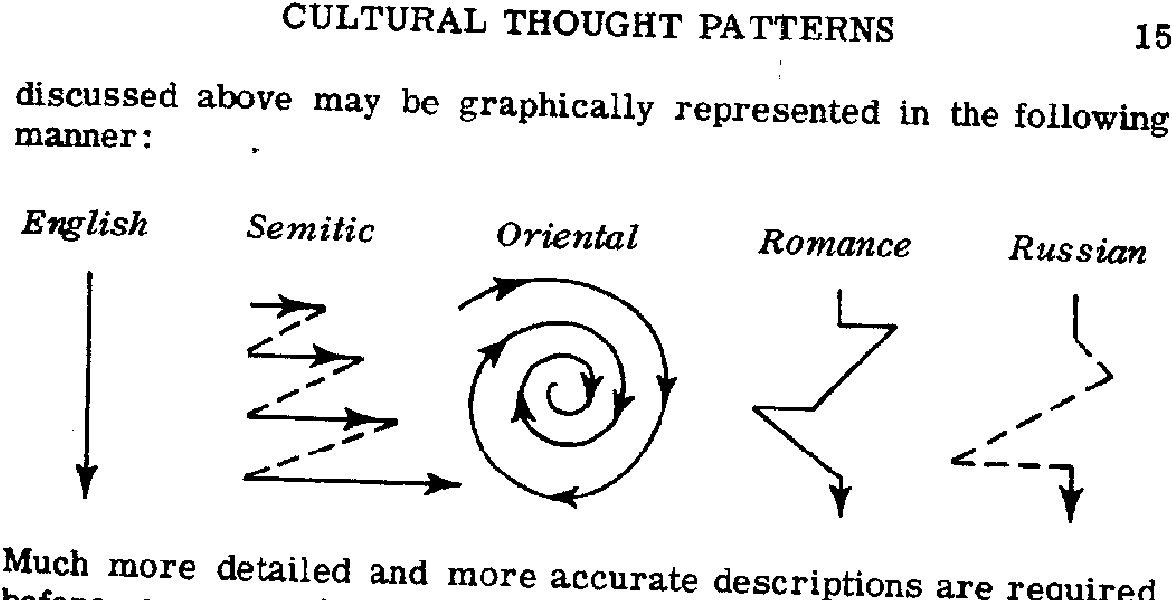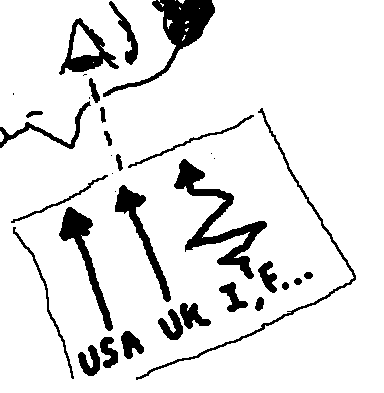
1.
.
Descriptive intercultural education
inevitably falls into the trap of ethnocentrism and stereotyping.
Take the case of the often-cited Kaplan. He sought to help his
readers understand the differences among various cultures with these
diagrams:

|
Kaplan, R.
(1966). "Cultural thought patterns in intercultural
education". |
But do Orientals really think they are reasoning in circles? Do Romance speakers -- thus Italians -- really think they are zigzagging in theit reasoning? Isn't this just how an American (Kaplan) sees their way of expressing themselves (because he doesn't notice or appreciate the terrain on which they are constructing their reasoning).
Kaplan
seems to consider the reality of Italian (or French...) speakers to
be perfectly flat and unproblematic; thus a straight line is
necessarily the shortest distance between two points (e.g. between a
premise and a conclusion). Digressions are therefore to be
considered zigzagging, a waste of time and energy..


.
But if we situate ourselves "on the
terrain" (if we learn to see the reality, as lived by Romance
speakers as THEY live it and see it), then perhaps a zigzag is indeed
the shortest distance between two points.
.

In other words, only if we learn to see the reality of our interlocutors, by situating ourselves on their terrain, can we appreciate the "reasonableness" of their mode of thinking. To see their reality from OUR point of view "above it", without taking into consideration what THEY see as "obstacles", is to oversimplify and to misunderstand.
So instead of describing other cultures in terms we can understand with out mental framework, we must learn to TRANSFORM our consciousness, i.e. change that framework.
Intercultural
education based on a transformation of consciousness must
therefore act on all three levels of the psyche:
-cognitive
-affective
-volitional
(Descriptions of cultures typically act on only one level: the cognitive)
How?
|
1. Observe foreign ‘twin’; playact her or him Change: subjects define target values, see how their ‘self’ hinders perception Tools: ethnographic checklists/practices à la Malinowski 2. Formulate intuited values as maxims Change: from an epistemic to a volitional stance Tools: Stanislavski's State of "I am" and Through Action 3. Divest (existentially) Change: from willfulness to anomie Tools: Bracketing à la Husserl 4. Invest (existentially) Change: from anomie to new willfulness Tools: Guided associations (Freud) using maxims 5. Act and verify Change: new needs, intents, perceptions Tools: Simulations with colleagues, then real-life interaction, first in controlled situations; subsequent debriefing and, if necessary, reformulation of target values. Patrick Boylan and Nadia Mari, "Being one of the group" > click here |